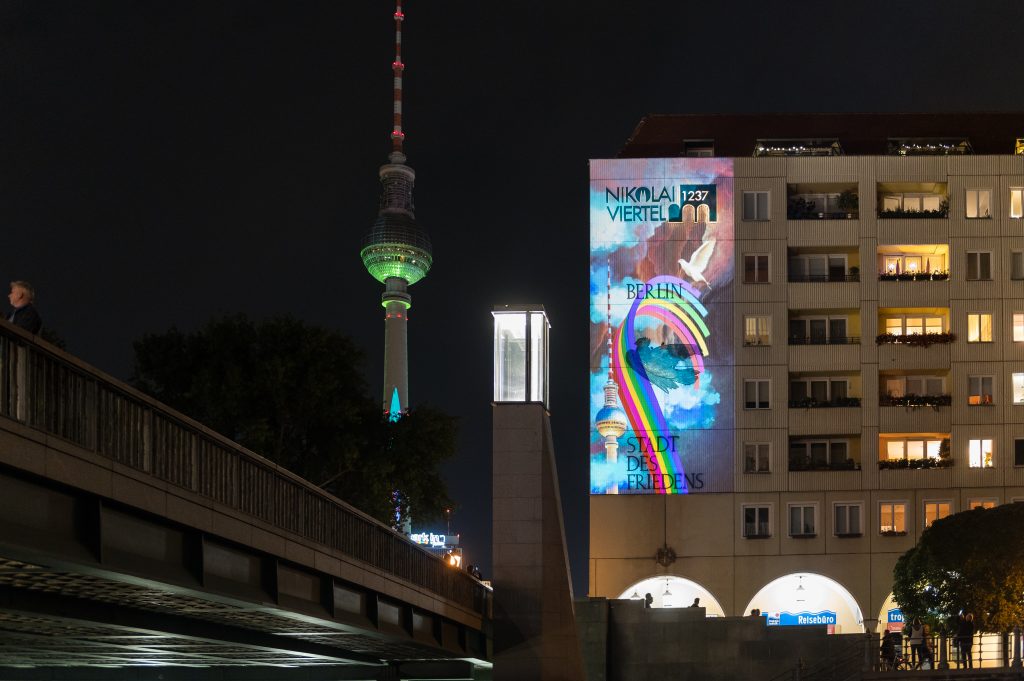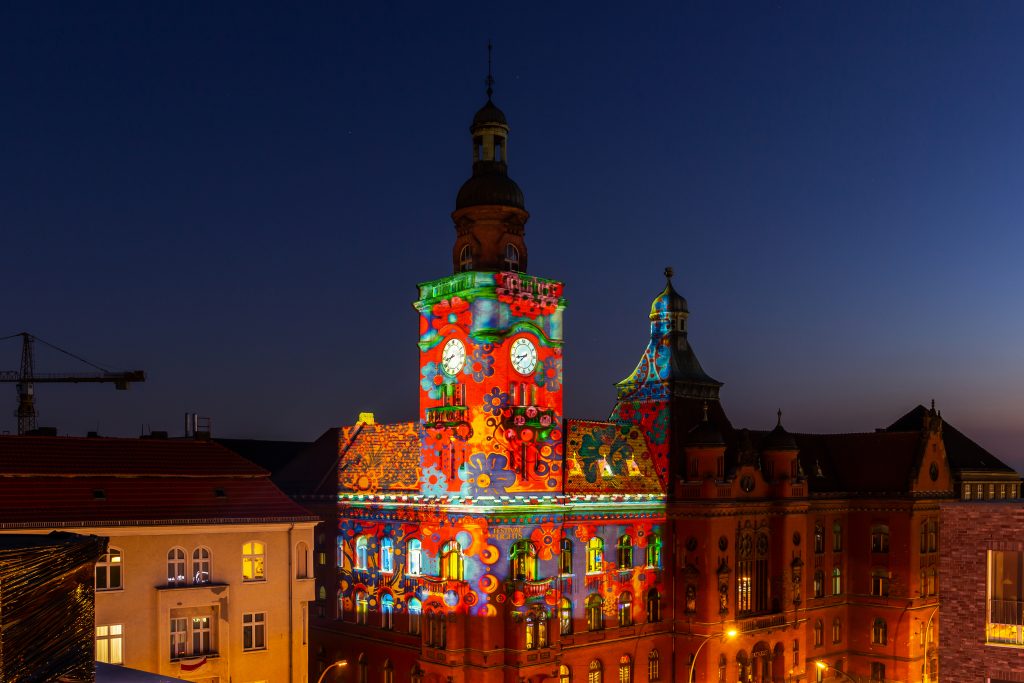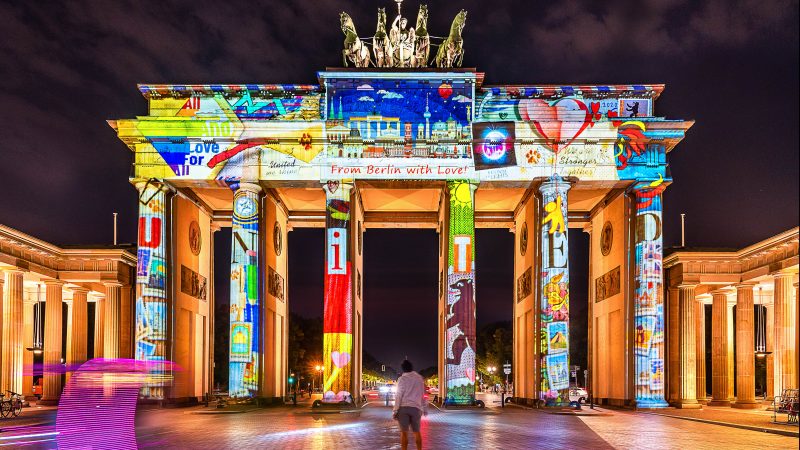Neighborhoods in light

There are 12 districts in Berlin and within them 96 neighborhoods with their very own history. 96 faces that shape Berlin. Because: Berlin is not just Berlin. At the FESTIVAL OF LIGHTS, some of these faces of the capital were beautifully illuminated, drawing attention to their special features and inviting visitors to stroll around. The main partners behind the light art were Berlin housing associations, which created an annual highlight for their tenants.
The Nikolai Quarter. The cradle of Berlin.
Firmly in municipal hands, the neighborhood presented itself in the festival with illuminated buildings and impressive light art installations
With around 32,000 apartments, WBM Wohnungsbaugesellschaft Mitte owns the highest proportion of rental apartments in Berlin. Around 800 of these are located in the Nikolaiviertel, the capital’s oldest residential district. In addition, there are numerous commercial areas with museums, retail, gastronomies and manufactories. At the FESTIVAL OF LIGHTS, the WBM Wohnungsbaugesellschaft Mitte invited visitors to an illuminated walk through the ensemble of historic town houses and new buildings.
The “Gateway to the Nikolai Quarter,” the former Nathan Israel department store on Rathausstraße, was staged with a still projection of the quarter’s most famous buildings. The Berlin Bear had also climbed the roofs of these buildings, boldly and cheekily. Was he waving to the visitors from high up there?

On the historically recreated building of the courthouse arbor for the first time at the festival closely associated with the place historical figures gave the honor. For example, Giacomo Casanova, who resided here in the summer of 1764 in the “Inn to the Three Lilies”. Or the Elector Johann Sigismund, who fled from the White Lady in 1619 to the same house and met his end.

A popular photo motif among the spectators was the dove, based on a design by Pablo Picasso, on the facade of the corner building on Rathausstraße. By means of video production it was brought to life and flew accompanied by rainbow-colored doves into a sky covered with fleecy clouds.

A floating luminous band of red poppies stretched through the treetops of the narrow streets Am Nussbaum and Probststraße. Every breeze transformed them into a dancing sea of flowers. In a small park behind St. Nicholas Church, the visitors were drawn into an intoxicatingly changing sea of lights that began at the roots of the trees and climbed in sweeping arcs to their crowns.

People strolled relaxed through the neighborhood, looked at the neighborhood in the festival light, stopped, photographed …. and on a small square on the banks of the Spree you could see dancers spinning, but there was no music. The riddle was quickly solved: the projection of well-known and popular dance drawings by Berlin milieu painter Heinrich Zille on the façade of the Neues Marstall on the other side of the Spree. The cheerful dancers seemed to “sway” directly on the water and encourage people to do the same.
Communal meeting points in the Neighborhoods
In the festival, the facades of city halls or shopping centers are the mirror of what makes the individual neighborhood lovable and worth living in.
As public institutions, four town halls also participated in the 17th festival year with colorful installations. In keeping with its location in Berlin, Köpenick City Hall played with the themes of water and sports, made possible by the Köpenick Cultural Office and 6 Köpenick housing cooperatives. A gadget that was gladly used was the possibility to make the image come alive by means of augmented reality. And a visitor’s photo of the installation, which is predominantly in shades of blue, pleased the festival jury so much that it took a place among the 15 best impressions in this year’s photo competition.

Colorful floral and with a visual connection to the nearby Bürgerpark, the Pankow City Hall showed itself, made possible by the Rathaus Center Pankow directly opposite. At the Marzahn-Hellersdorf Town Hall, the people of Marzahn in particular marveled at a collage of views of the district, while the adjacent residential high-rise on Helene-Weigel-Platz featured a fitting picture story about the creation and urban development of the square over the past 35 years. For one evening, the Rathauspark Lichtenberg was illuminated in an atmospheric installation, initiated by the Lichtenberg district office.

Pankow City Hall 
Rathauspark Lichtenberg 
Marzahn-Hellersdorf Town Hall & highrise Helene-Weigel-Platz
In Steglitz-Zehlendorf, not only the Lichterfelde-Ost train station was bathed in a sea of flowers, but also the adjacent LIO Lichterfelde – the name is derived from the old signal box name – was suitably illuminated with a rail motif. In the district of Tempelhof, light enthusiasts were drawn to the waterfront, more precisely to the Tempelhofer Hafen shopping center. The former inland port with its former half-timbered warehouse has preserved the historic harbor image for its current use as a shopping center. On the huge projection screen on the water side appeared a colorful, eye-catching underwater world … fish in all known colors, corals, jellyfish, deep fish … magnificent creatures from the seas of the world. And this image could also be brought to life with augmented reality. In Spandau, the Spandau Arcaden and the Quartier Waterkant present themselves in light. Here, too, the WBM Wohnungsbaugesellschaft Mitte offered a cultural highlight, especially for the citizens living there. The motif on the shopping center was – how could it be otherwise – about shopping. And the residential area located directly on the water was atmospherically illuminated with thousands of lights and appropriately accompanied by a musical life act.
You want more great stories about the “Festival of Lights”, the locations and partners? Browse through the magazine or directly on the festival page with impressive pictures and videos.














